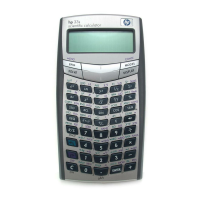2–12 RPN: The Automatic Memory Stack
File name 33s-English-Manual-040130-Publication(Edition 2).doc Page : 388
Printed Date : 2004/1/30 Size : 13.7 x 21.2 cm
Now study the following examples. Remember that you need to press
Ï
only to separate sequentially–entered numbers, such as at the beginning of a
problem The operations themselves (
Ù
,
Ã
, etc.) separate subsequent numbers
and save intermediate results. The last result saved is the first one retrieved as
needed to carry out the calculation.
Calculate 2
÷
(3 + 10):
Keys: Display: Description:
3
Ï
10
Ù
Calculates (3 + 10) first.
2
w
¯
Puts 2 before 13 so the division is
correct: 2
÷
13.
Calculate 4
÷
[14 + (7
×
3) – 2] :
Keys: Display: Description:
7
Ï
3
¸
Calculates (7
×
3).
14
Ù
2
Ã
Calculates denominator.
4
w
Puts 4 before 33 in preparation for
division.
¯
Calculates 4
÷
33, the answer.
Problems that have multiple parentheses can be solved in the same manner using
the automatic storage of intermediate results. For example, to solve (3 + 4)
×
(5 +
6) on paper, you would first calculate the quantity (3 + 4). Then you would
calculate (5 + 6). Finally, you would multiply the two intermediate results to get the
answer.
Work through the problem the same way with the HP 33s, except that you don't
have to write down intermediate answers—the calculator remembers them for you.
Keys: Display: Description:
3
Ï
4
Ù
First adds (3+4)
5
Ï
6
Ù
Then adds (5+6)
¸
Then multiplies the intermediate
answers together for the final
answer.

